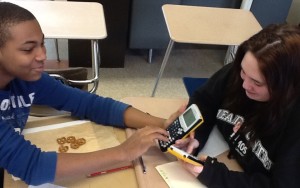Blog Archives
Check Out My Wordle
 A few months ago, I explored a website called wordle.net. As the website describes, Wordle is a toy for generating “word clouds” from text that you provide. The clouds give greater prominence to words that appear more frequently in the source text. You can tweak your clouds with different fonts, layouts, and color schemes. The images you create with Wordle are yours to use however you like. You can print them out, or save them to the Wordle gallery to share with your friends.
A few months ago, I explored a website called wordle.net. As the website describes, Wordle is a toy for generating “word clouds” from text that you provide. The clouds give greater prominence to words that appear more frequently in the source text. You can tweak your clouds with different fonts, layouts, and color schemes. The images you create with Wordle are yours to use however you like. You can print them out, or save them to the Wordle gallery to share with your friends.
I love using Wordle.net for math vocabulary activities!
I encourage you to check it out for a creative activity, project, presentation, pre or post vocabulary lesson, or assessment. You can type in words into the wordle website or copy text from an article. A sample of a wordle that I created from my favorite education topics is below:
10 Ways to Ensure a Successful Credit Recovery Program
 What happens when a student is not learning? Athena High School has created a Tier 3 response to intervention (RtI) program called the “Algebra Opportunity Academy” (Click here for a blog about the specifics of this program). As a result of this credit recovery program, 12 out of 12 students earned credit back for at least one quarter of Integrated Algebra. These 12 students are now on track to pass Integrated Algebra.
What happens when a student is not learning? Athena High School has created a Tier 3 response to intervention (RtI) program called the “Algebra Opportunity Academy” (Click here for a blog about the specifics of this program). As a result of this credit recovery program, 12 out of 12 students earned credit back for at least one quarter of Integrated Algebra. These 12 students are now on track to pass Integrated Algebra.
In discussing this data with my colleagues, it was clear that there were many reasons why this program worked. The following are a list of 10 ways to ensure a successful credit recovery program (in any content area):
- Colleague support: This was the most essential piece of this program. This credit recovery program was highly dependent upon the math teachers of these credit deficient students. If the math teachers did not trust the rigor or the objectives of the program, we would not have been able to adjust student grades. Colleague support was also important in the selection of students and in the selection of the power standards that were taught in the program.
- Administrator support: As with most programs, administrators can either be a help or a hindrance. The administrative team at our school supported the math departments efforts and assisted in contacting the students and parents.
- Parent/Guardian support: All students in this program had parents that set the expectation that attendance was mandatory and supported the teachers in their efforts. They also drove or arranged rides for their children when necessary. The transportation component helps to ensure parent commitment.
- College student help: There were 12 students enrolled in the program. Some might argue that a 12:1 student to teacher ratio is acceptable. Perhaps, but a 2:1 student to teacher ratio is better and offers much higher instructional intensity. We arranged six math education college students to come in to assist us in the program. Many of these students needed a much smaller group to fully master a topic.
- Quick and specific feedback: As this program took place over a short amount of time, it was important to give the students as much feedback as possible to ensure that they were able to “correct” their mistakes. The Castle Learning website assisted us in providing quick and specific feedback.
- Multiple modalities: This program offered students an opportunity to experience many instructional models: direct instruction, small group activities, computer programs, SMART Response Clickers, Dry Erase Boards, and other lessons that required them to move around the classroom.
- Goal Setting: All students knew their current grade in the course and set a specific numerical goal that they wanted to achieve.
- High expectations for behavior and academics: Clear behavioral and academic expectations were given to students and parents verbally (each parent was called individually) and in written form.
- Targeted assessments: Assessments focused on the essential understandings of the first 2 quarters of Integrated Algebra. The assessments were a combination of written and electronic (Castle Learning).
- Food: All students were given snacks and a lunch. Some could argue that this is not needed, but the food resulted in higher student morale, greater student energy, and a positive motivator to work hard.
For more information, please E-mail andy.maillet@greece.k12.ny.us or Tweet @AndyMaillet.

 My name is Andy Maillet and I am an instructional math coach at Athena Middle and High Schools.
My name is Andy Maillet and I am an instructional math coach at Athena Middle and High Schools.



